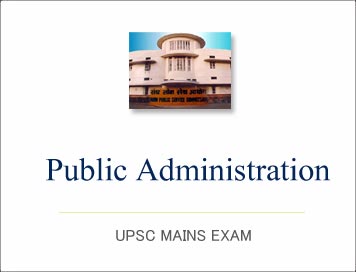UPSC Public Administration IAS Mains 2015 Categorised Paper -1

UPSC Public Administration IAS Mains 2015 Categorised Paper -1
Paper-1:
Section-A
Q1.Answer the following questions in about 150 words each: 10×5=50
A. Waldo’s The Administrative State’ provides a fundamental challenge to some
of the orthodox premises. Explain. (Introduction)
B. Discuss how the Public Choice Theory promotes the concept of ‘Steering’
and undermines the concept of ‘Rowing’ in visualising efficient and effective
administration. (Introduction)
C. “Delegated Legislation is a necessary evil.” Comment. ( Administrative
Law)
D. Do you agree with the view that the charismatic approach of the mid-1970s is
a “new version” of the Classical Trait Theory of Leadership? Give reasons.
(Administrative Behaviour)
E. “The term policy implementation is in some respects preferable to the label
public administration.” Argue. (Public Policy)
Q2. 20+15+15 marks
a. “Globalisation has transformed the nature and character of State from
traditional administrative Welfare State to a Corporate State.” Analyse the
changes in the nature of public administration in this context.
(Introduction)
b. “Contemporary Organisational theory seems further afield of Chester Barnard’s
Functions of the Executive than of organisational ecology.” Examine the
statement in the light of ecological elements in Barnard’s thought.
(Administrative thought)
c. “PPPs serve too many parties and too many interests … to be focussed.”
Identify in the context of the statement, the parties involved in Public-Private
Partnerships and their conflicting aims. (Organisations)
Q3. 20+ 15+ 15 marks
a. “Follett’s work was not directed towards the resolution of the conflict of
ideas, but towards the resolution of structural conflicts between workers and
capitalists.” In the light of the statement critically evaluate Follett’s idea
of dynamic administration. 20 (Administrative thought)
b. “Information constitutes the life-blood of the functioning of an organisation.”
Explain the utility and significance of communication in decision-making. 15
(Administrative Behaviour)
c. “Legislative action is not subject to the rules of natural justice.” Explain
the exceptions to the rule of natural justice. . (Administrative Law)
Q4. 20+15+15 marks
A. “Right from the days of the ‘Peoples’ Charter’ to the new concept of `Precariat
Charter’, the concept of Citizen’s Charter and its scope is constantly
evolving.” Comment. (Accountability and Control)
B. “Weberian model of bureaucracy lacks emotional validity when applied to
modern democratic administration.” Comment. (Administrative Thought)
C. How far do you agree with the view that the growing influence of media comes
in the way of agenda-setting by the Government? (Accountability and Control)
Section-B
Q5. Answer the following questions in about 150 words each : 10×5=50
a. “Comparative Performance Measurement (CPM) bridges everyday work
experience with the broader horizons of comparativism.” Explain. (Techniques
of Administrative Improvement )
b. Analyse the relevance of Whitleyism in contemporary employer — employee
relationship. (Personnel Administration)
c. “No significant change can be made in the budgetary process without affecting
the political process.” (Wildaysky). Analyse. (Financial Administration)
d. “In the appreciative systems of policy makers, goals are subsidiary to norms
and values.” (Vickers). Explain. (Public Policy)
e. Show in what way the Gender and Development approach differs from the Woman
and Development approach. (Development Dynamics)
Q6. 20+15+15 marks
A. “Administrative ethics is a process of independently critiquing decision
standards, based on core social values that can be discovered, within reasonable
organisational boundaries that can be defined, subject to the personal and
professional accountability.” (Denhardt). Explain. (Personnel Administration)
B. “Lenin’s concept of Socialist management refers to directing the
organisational development of Socialist society.” Explain. (Public Policy)
C. “Policy analysis is incomplete without taking into account policy delivery.”
Argue. (Public Policy)
Q7. 20+15+15 marks
A. How does Ferrel Heady rationalize the three stages of development in
comparative administration? (Comparative Public Administration)
B. Distinguish between ‘Codes of Conduct’ and ‘Codes of Ethics’. Justify your
answer. (Personnel Administration)
C. “E-Governance creates a direct relationship between the Citizen and the
State.” In this context, explain the changing role of the elected
representatives. (Techniques of Administrative Improvement)
Q8. 20+15+15 marks
A. “The concept of political feasibility in policy
alternative is a probabilistic concept and is related to each policy
alternative.” In the context of the above statement analyse Dror’s contribution.
(Public Policy)
B. “The position-classification attempts to establish a triangular relationship
between duties and responsibilities, working conditions and qualification
requirements.” Elucidate. (Personnel Administration)
C. “MIS, PERT and CPM have accelerated the process of reinventing 0 & M.” In the
context of the above statement, explain the recent developments in managerial
techniques. (Techniques of Administrative Improvement)
